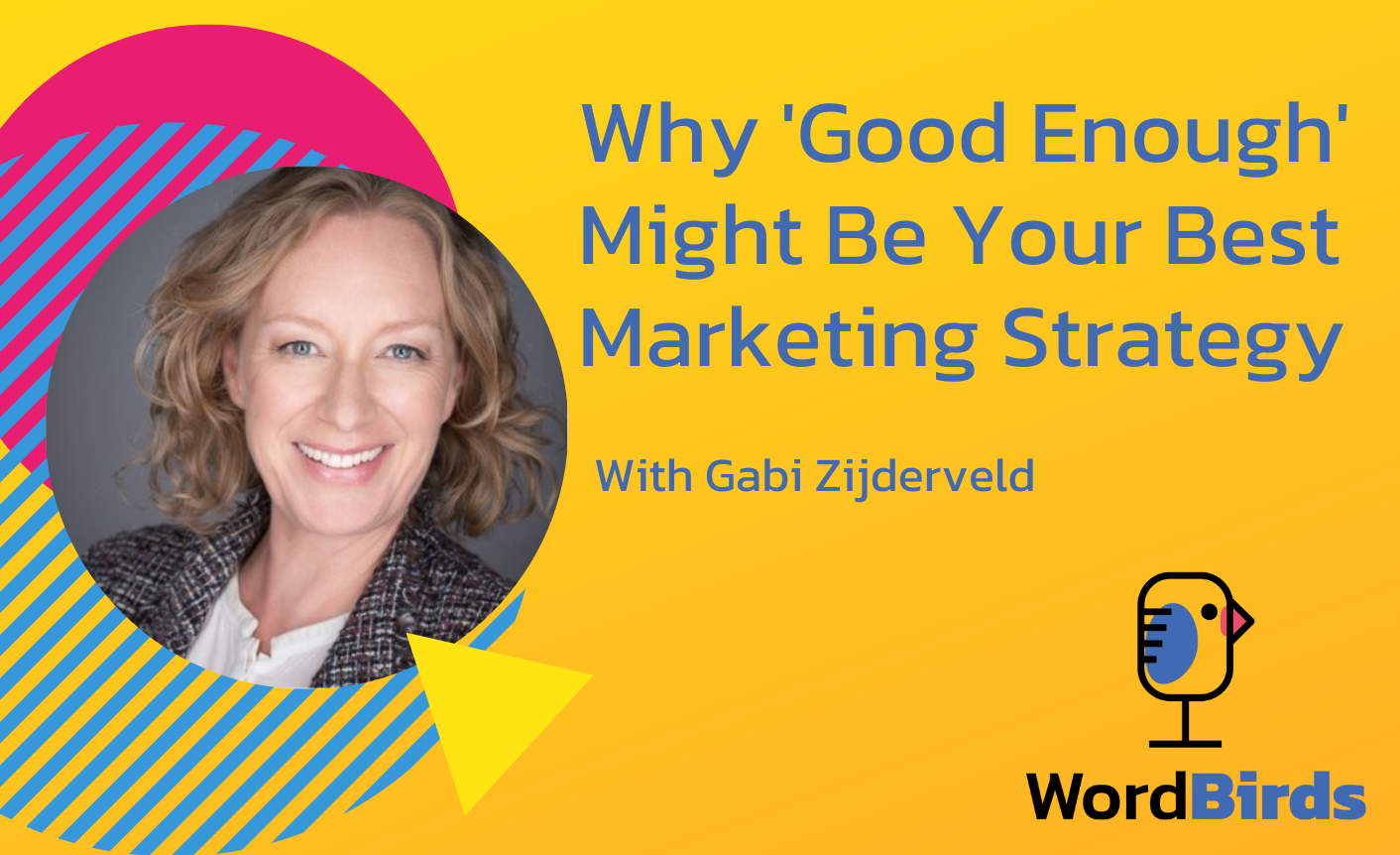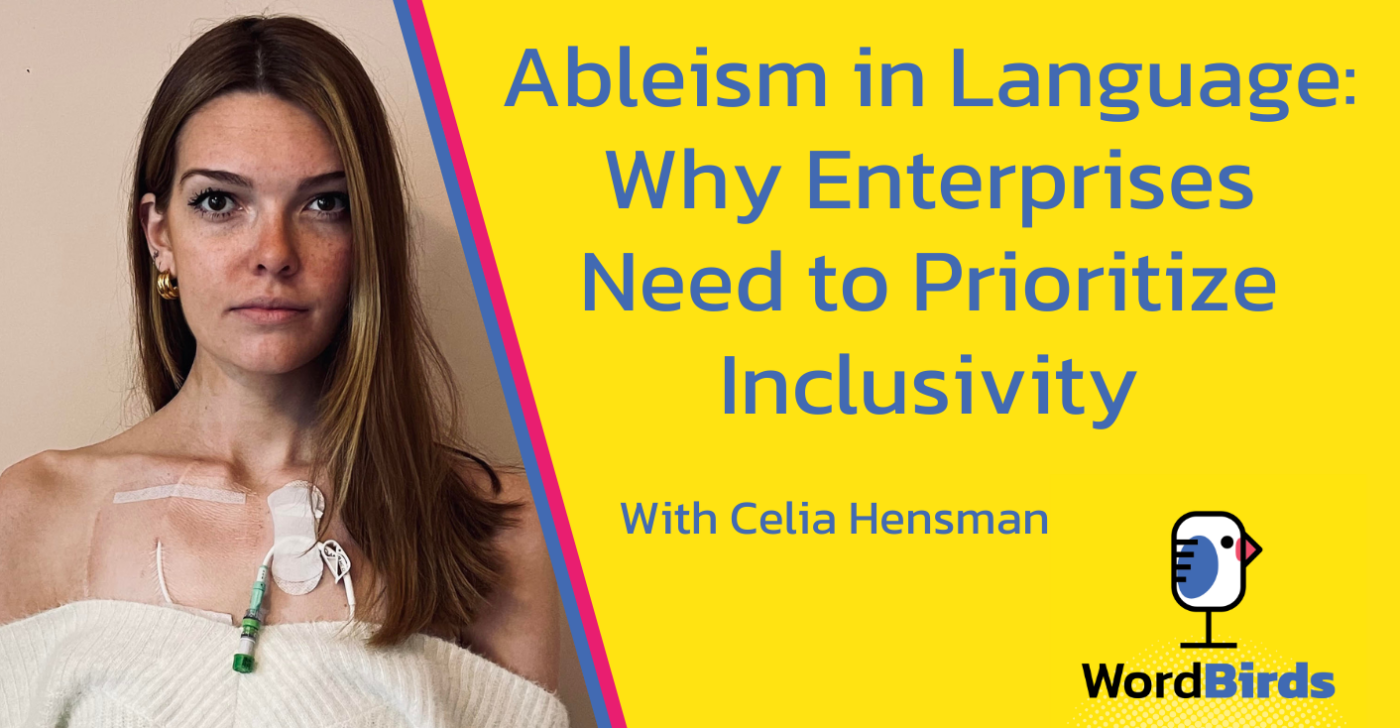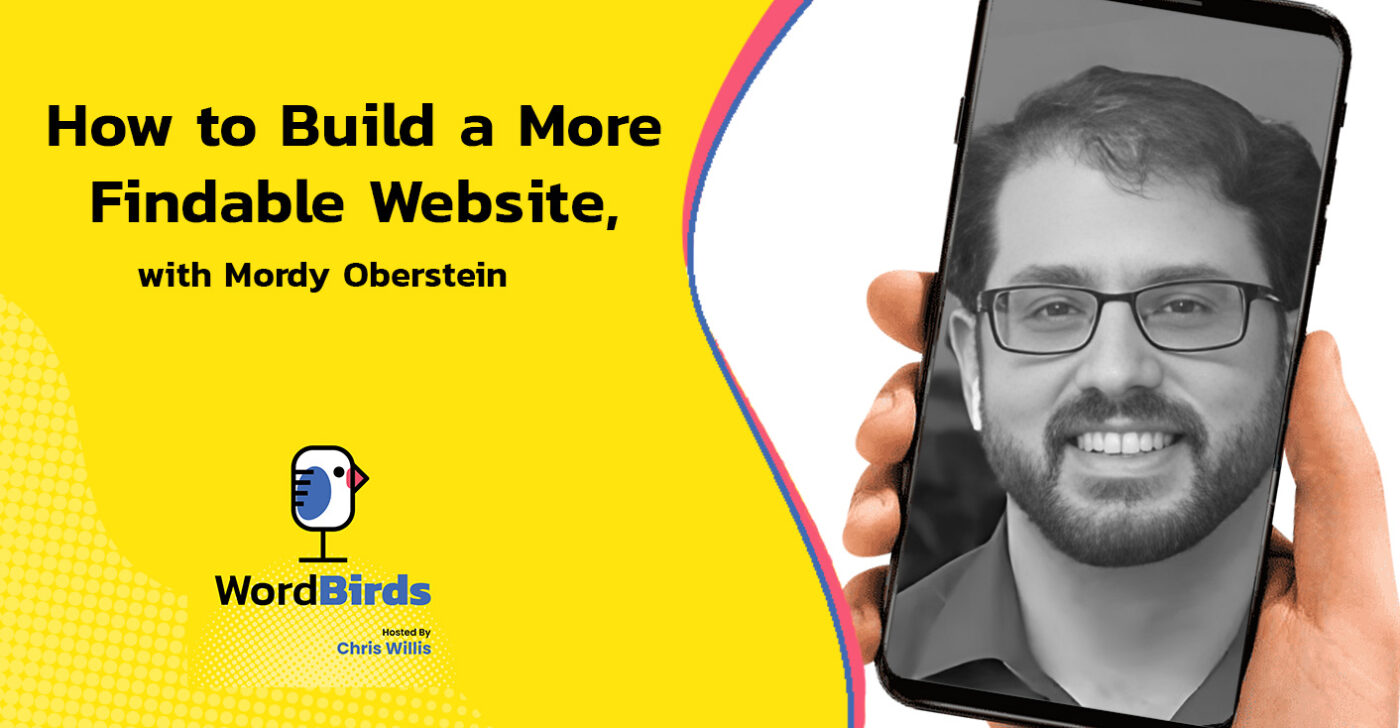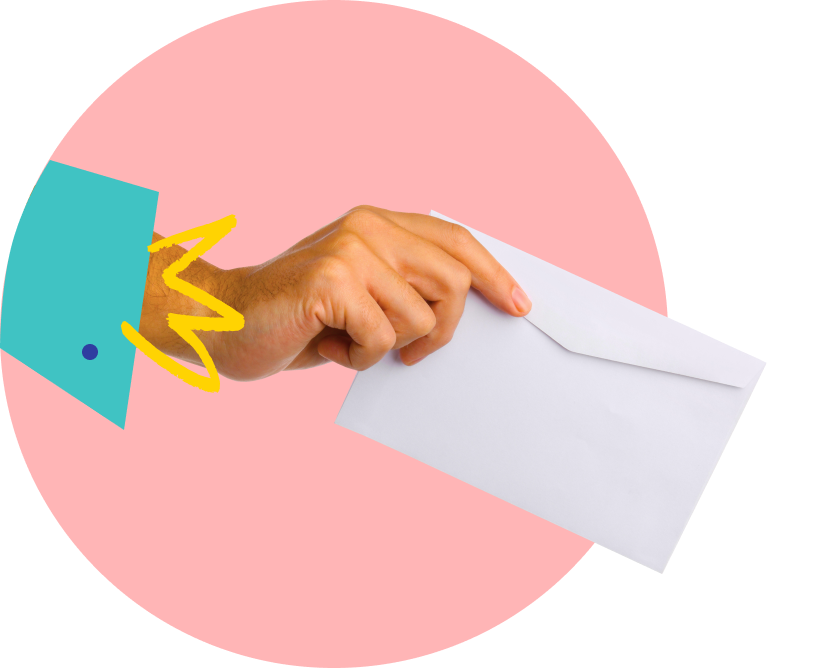Are you asking the right questions to find out the reasons why you’re creating a piece of content? And once you’ve created that piece of content, is good enough good enough?
In this captivating interview, we delve into the world of marketing and content creation with Gabi Zijderveld, Chief Marketing Officer at Smart Eye. Gabi shares her insights on two essential marketing tactics: the power of adaptation and the embrace of imperfection.
The interview kicks off with Gabi recounting an extraordinary experience she led—a virtual book launch and tour during the challenging times of the COVID-19 pandemic. Gabi faced the daunting task of pivoting from traditional in-person events to a virtual platform. She explains how they not only successfully adapted to the new circumstances but also exceeded their own expectations, reaching a global audience in unprecedented ways.
Gabi also advocates for a refreshing concept—’good enough’ content. She challenges the common pursuit of perfection and argues that, in many cases, striving for 100% perfection can hinder progress and waste valuable time. Instead, Gabi suggests that marketers should focus on creating content that meets the target market’s needs and serves its intended purpose.
Join us as we unravel tales of innovation, resilience, and the pursuit of excellence in marketing, guided by Gabi’s valuable experiences. Discover how the art of adaptation and the acceptance of imperfection can lead to marketing success in today’s dynamic landscape.
Watch the episode
Listen to the episode
Read the full episode transcript
Gabi, welcome to the show!
Thanks so much for having me, Chris. As always, great to talk to you.
This is very exciting. It’s going to be a great conversation. So let’s get started. I want to drop right into the quick fire. Quick short answers and then we’re going to come back and we’re going to drill into them.
What’s the best and most successful campaign content you’ve been involved in?
It was the best, I think, but maybe even more, the most memorable and the weirdest. And it was the book launch and book tour for our CEO’s book. It’s a tech-infused memoir called Girl Decoded. And it all happened in April, 2020. It was weird.
Oh wow, I can’t wait to talk about that. What was your worst content campaign?
That was about 10 years ago. I was at IBM and we were working on messaging and especially a website — more educational in nature on a very tech-y topic, KVM, and it sucked. And I’ll tell you later why.
So out of the two of those, which are fantastic examples, which one did you learn the most from?
Oh, the last one, that technical messaging and website that was disastrous. And we fixed it. I learned a lot and still have that in the back of my mind.
So let’s talk about that one. Tell me a little bit more about what that was.
Okay, so I had just moved from one division to a completely different division at IBM. And it was in the Linux team, and in itself really interesting because IBM didn’t sell Linux distributions, but Linux influenced the sale of hardware, software, and services to the amount of $6 billion a year. So a big deal for IBM. And years later, they would buy Red Hat.
Let's say a piece of content is like a 90% complete, to get it to that 100% that you naturally would drive it to, the effort that takes and that additional time it takes stands in the way of applying that energy to something else. Click To TweetKVM, Kernel-based Virtual Machine, was an open-source hypervisor. And I had just joined that team a week prior and we were tasked by the second person at IBM to create a market for this thing. Now I knew nothing about what that all meant. And I teamed up with a coworker who was super nice and who had been in the virtualization space for quite some time. I really liked working with him and he tried to explain it all to me.
Together we were tasked within a week of standing up messaging and a completely new website, or at least a homepage and a few pages underneath. And as we’re working on it, I was enjoying this partnership with this new colleague, but I really didn’t get it. We’re writing all this stuff and I’m like, “what the hell is this supposed to mean?”
Then eventually we finalize the first near concept and are ready to show it to our executives. And my boss’s boss, I’ll never forget, she looked at that homepage with our goobly goop on it and she said, “what do you think? Your clients are stupid?” And it’s stuck because I just sat there and “I’m like, yeah, this is shit.” Like I don’t even understand it. Why didn’t I push back, right?
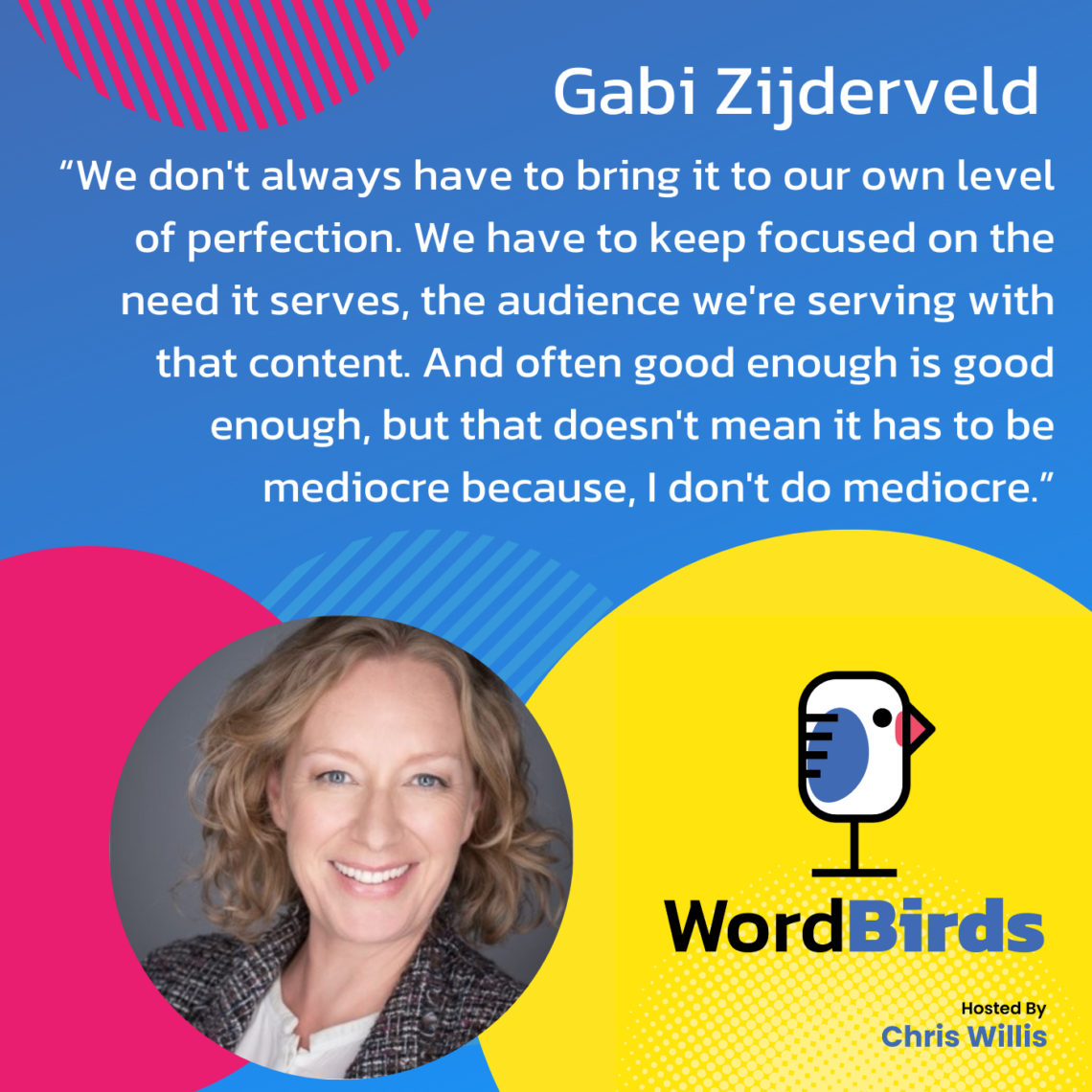
So that in itself was a huge lesson learned and we can talk more about that later, but essentially she sent us back to the drawing board. That’s when I started what I like to call my “why questions:” Why does this exist? Why does it matter? Why are people paying money for this? Why is this making companies better? Why, why, why? It’s those toddler questions, right? They always ask, why? But by digging into this, I finally got the answers so I could understand it. And then I could put my product marketing hat on and create something that made sense.
But it was, “what do you think? Your clients are stupid?” I’ll never forget that!
It’s a great entry to a new technology overview. It really builds you up, makes you feel good about your work.
Yes, exactly. And honestly, when she said that I was so pissed off. I’m like, “what?” Because I’d been doing this stuff for quite some time. So you have maybe a bit of an ego and then after I calmed down a bit, I was like, “she’s so right.” It’s the best feedback I’ve gotten in ages. She’s so right. And we fixed it and then it was good and it became awesome.
That’s interesting, really thinking through the full picture of the why as to what you’re creating and then building the message around that why. Versus just taking things from the technology group, turning them into readable content and putting them out into the world. Because that doesn’t always tell the story that’s going to be consumed by the audience you’re creating it for, even though in this case, you’re communicating something very technical and kind of boring. You still needed to tell the story that was going to pull people in.
Yes and I also won’t forget that. I think one of the big points around this technology is that target audiences really thought it was some esoteric technology that wasn’t ready to be deployed in the enterprise. I think our headline on the page was “KVM: Ready for Business.” And then a few layers down, you had all that tech talk and the geeky stuff that you needed to have there. But it was that attention-grabbing that was like normal talk, right? Like how people talk to each other. Rather than complicated tech talk that doesn’t make any sense.
Good enough is good enough. Click To TweetBut, I love the why questions. And also, later at Affectiva when we created the category of emotion AI, we really focused on that messaging and it was all about the why, right? Why does this exist? What’s the raison d’etre, as the French would say? Why does it exist? Why are we building this? Why are we better at this than anyone else? Why would someone pay money for this? Why would this be used in healthcare, education, automotive, you name it? And to this day, I come back with that.
Well, it’s a great way of talking about the need for the solution. I think that’s been a thread that we’ve heard — if you’re listening to this show right now and you’ve listened to the last three or four episodes of this season — in every episode. And I’m not surprised because of the people that I’m talking to.
Identifying the actual need in the marketplace within the persona that you’re selling to, finding that emotion that keeps somebody up. Versus just telling people what your solution is. Like, this is what we do. You should just know the thing we do. No, I want to find out why this matters to you. And I’ve heard that from literally every guest on the show this season that the why, the emotion behind it, the reasoning behind it, the thing that’s going to make it interesting to the people that are potentially going to buy this product is the difference between success and failure.
Just saying, “this is a thing, here you go,” doesn’t engage with the audience. It might provide a value overview, it might provide a whole lot of things, but if you don’t understand why I would look at it, what would attract me, why I would read it, it just isn’t going to work. And I feel like that’s exactly what you corrected was, “here’s a thing, now here’s why you care about that thing.”
Yes and I love how you’re describing it. That’s exactly it. I think we all at times lose sight of it. Too many tech companies out there frequently lose sight of it. I’m sure you see it all the time too. We all get these unsolicited emails and it’s like, you haven’t touched on why I would care about this.
For years, we’ve been talking about Goals, Governance, and Guidance: “Here, let me tell you about what we do: It’s goals, governance, and guidance.” I would like you to tell me in your life, when was the last time that you woke up in the middle of the night thinking, “huh, I forgot about goals, governance, and guidance. I need to do that tomorrow.” And the answer, I’ll save you some time, is never. You’ve never had that.
So we spent a lot of time prepping and creating materials that we could give to them and basically say, here's a package, can you please promote it? And they all would and we’d get even more amplification. Click To TweetBut if we talk about the persona of a content market or at a bank. When was the last time they woke up thinking about regulatory compliance or complexity of the content that they’re trying to deliver because of the financial regulations and rules in the space, like that’s a thing. And how do we address those things? That’s a problem that somebody has. You don’t know that you have a problem with goals, governance, and guidance. I would suggest that you do, but you don’t know that.
But you don’t articulate it that way. So that phrasing doesn’t ring a bell with me because you don’t think in those terms.
I’m selling you medicine for a disease that you’ve never heard of and you don’t know you have, and I need to convince you that you have it. Versus finding the thing that you have, that you know, like my arm hurts. Cool, let me tell you what we do for your arm. And so many companies, so many marketing organizations don’t do that, they just go, like this is what we have.
Yes, I love how you said that “I’m selling you medicine for a disease you don’t have.” Yes, that’s exactly it and it happens too much and it’s at organizations.
It really is and the companies that do well are the ones that are putting candy out in the front of their houses on Halloween with whole candy bars. Here’s the thing and you just immediately understand it. You’re like, I’m going to go and I’m going to try the candy. And the companies that are selling medicine are standing on the side, like why am I losing all my leads to these other companies? Because they’ve identified what I want. My pain point is I like candy and I’m going to go get some.
Looking at your best and most memorable campaign. Tell me a little bit about the book.
That was really quite something. So our CEO, Rana el Kaliouby, she’s the founder and CEO — we’ve since gotten acquired by the company Smart Eye, where she and I to this day both work. We effectively merged our two companies. She’s a fairly young computer scientist that grew up in the Middle East, got her PhD in Cambridge, UK, then came to Cambridge, Mass to the MIT Media Lab.
From there, she spun out the company Affectiva with her co-founder. So scientist turned entrepreneur, Middle Eastern woman, single mom, as you can tell now, checks all the boxes, right? And a super interesting profile, she’s very charismatic, a great speaker, and a really fantastic person. She’s become a very good friend over the eight plus years I’ve worked with her. By the way, she’s now recognized as an AI thought leader and that started about six years ago when her business profile, her tech profile really started rising and we also started that category of emotion AI. So she was a very unique persona in tech and in the rapidly emerging new AI space.
I've heard that from every guest this season that the why, the emotion behind it, the reasoning behind it, the thing that's going to make it interesting to the people that are potentially going to buy this product, is the difference between success… Click To TweetShe had an opportunity to write a memoir that was offered to her by Penguin Random House. And part of me was like, you’re like, what, 39, 40 years old? What do you mean, you’re writing a memoir? By the way, you’re a CEO, you don’t have time for this. The running joke, by the way, was that I was her CMO, but also her CNO, her Chief No Officer. So I said, “no, you don’t have time for that.” But of course, when Penguin Random House comes to knock for you to write your memoir, you’re not going to back down, right? I got it.
So I saw this book coming rapidly and spoke to her a lot about it. I was even in some meetings with Penguin Random House where we went to New York and met that team. All super awesome. She got a publicist who focuses on literature, she had a literary agent. This whole space that I hadn’t really, you hear about it, but I’ve never worked in it before.
So that was just interesting in itself and I had an opportunity to read early versions of the book and give feedback, which she considered. And then of course, the book’s going to launch April 20, 2020.
Perfect timing.
She has this fantastic book tour lined up, television appearances, the typical enchilada that also Penguin Random House with a good publicist will line up for you. And as we know now, the whole thing came falling apart. So of course she’s freaking out because this is her book. She wants it to be a bestseller and it got on a Washington Journal or Washington Post bestseller list. So she did achieve that, but totally freaking out.
At one point I said, Rana, “it’s okay, we’ll do a virtual book launch and a virtual book tour. Let’s go talk to Penguin Random House” and they’re like, “What? No idea what you’re talking about.” We just started brainstorming ideas. I’m like, we’re just going to do it. It was amazing. It was obviously very content heavy. We focused on the book. We had excerpts of it. The book had various themes. We did a humongous press outreach. I think she got something like 110 pieces of media coverage for the book.
So we, as a marketing team, basically invented a whole series of LinkedIn live streams. And mind you, this is very early on in the pandemic when no one was yet sick and tired of all this online nonsense. And she was able to get all these noteworthy tech and AI luminaries to come on her live streams because these people were stuck at home as well. You could never get them because they would always be traveling, but they’re at home and they’re like, yeah, I’ll come on. We had these amazing live streams. I think we did like 15, maybe 18 of them, over 80,000 viewers from 100 countries or something ridiculous like that.
Identifying the actual need in the marketplace within the persona that you're selling to, finding that emotion that keeps somebody up. Versus just telling people what your solution is. Click To TweetShe did a lot of podcasts, including the Tim Ferriss podcast. We would send these pre-order email blasts that had open rates of 40%. Like I’ve never seen emails that have an open rate of 40%, right? So oddly enough, in this really horrible time — we’re at the height of the pandemic, thousands of people around the world are dying every single day and are stressed out beyond belief — somehow we managed to pull off this amazing book launch and book tour that lasted a good half year. And it generated all this content that we could milk for a long time after that and build on and chop up into little pieces and send it out over different channels.
We had a virtual book party when the book launched. That was hilarious! Suddenly her parents in Dubai were able to join because otherwise they probably would have never traveled to the US for a book party at a bookstore. So we had a few hundred people join a virtual live stream. We created this virtual goodie bag for everyone where we basically had a Dropbox file with all this cool stuff in it. Like Rana’s favorite recipe, and she loves to do Zumba, so a little video of Rana doing some Zumba instruction, like all this fun stuff.
We had a lot of fun with it, but you know what the interesting thing was after all was said and done? She was still very upset that all her in-person appearances, of course, had gotten canceled. Including a Ted Talk that would have been with an audience of 700 people, but we reached tens of thousands of people around the world doing this virtually in the height of the pandemic, when people were stuck at home and getting bored out of their mind after about a month into it. The reach was way bigger than a traditional in-person book launch and book tour would have ever been. So against all expectations, it ended up being a really good success. It was weird, fun, and quite memorable. So for that reason, I would qualify it as my best.
It’s kind of amazing because I’m sure that book tours are great and if that had happened in the world, good things would have happened. But the amplification that you got out of moving it, like shifting gears and moving that to the cloud, allowed a much broader audience from a wider area to participate. It had to have a downstream impact on the actual success of the book that you wouldn’t have had in person. It would have been cool to walk into a room, have people clap for you, and do your reading. Like that’s really neat. I would love to do that. But at the end of the day, if you care about getting your content out, this was fantastic. And the byproduct of it’s all the additional content that you got that you continue to get to use.
Exactly, and we would have never had that if it had taken place the traditional way, not to that extent.
It’s a great example of being able to creatively solve a problem and shift gears very quickly, but also to create that reusable content that becomes the basis of so many other things that you’re going to do. That, to be fair, if you stood in a room at Barnes and Noble in, I don’t know, New York City, you wouldn’t have guests, you wouldn’t have people coming on, you wouldn’t have tech luminaries. All of this is more valuable. It’s just complete amplification.
Yes, absolutely. Absolutely. Of course, we prepped really well. So when we would get these luminaries on, we would often get, if they were working in a company, their marketing teams involved. We’d prep and brief them. We’d also package up promotional content, right? Like here’s a sample tweet. Here’s a banner for LinkedIn that has the guest speaker and Rana together with our branding. So we spent a lot of time prepping and creating materials that we could give to them and basically say, here’s a package, can you please promote it? And they all would and we’d get even more amplification. It was quite something else.
But it was that attention-grabbing that was like normal talk, right? Like how people talk to each other. Rather than complicated tech talk that doesn't make any sense. Click To TweetWe were just in this go, go mode, right? Especially also because our CEO, whom we all really liked working with and had been working with for a long time, was so distraught. And we were like, we’re going to make this awesome. It was all hands-on deck at a time when we were all stuck at home. We had a blast, but it wasn’t until maybe a year later, my PR agency, who was very heavily involved and they were exceptional in this whole exercise, said we were invited to speak about this or write an article about it. So it gave us an opportunity to reflect on what we had done a year before. We sat back and we’re like, “that was actually amazing.” What we as a group managed to pull off with the support of this institution that’s Penguin Random House. I didn’t think we realized it at the time because we were just going, but afterwards it’s like, “wow, that was something else.”
It’s interesting that you had, I’ll call it a natural disaster, a global natural disaster that forced you into this situation. The take away for me is that you don’t necessarily need that natural disaster. Things fall in front of our campaigns all the time. If you can shift gears, find that excitement and creativity, this kind of outcome is possible. But you have to be willing to do that. You didn’t just say, “well, this sucks.” You shifted gears, this is what we’re doing now, took control, and moved in a different direction. And that direction worked.
So often we see people when the wall drops and it’s like, “well, I can’t go anywhere, there’s a wall in front of me.” And taking that decision to say, “we’re going to give this a shot and see what happens,” there’s only two things that could happen. One, it’s going to be great and one, it’s going to suck. But if you sit in one place, it’s definitely going to suck.
Yes, exactly. We had nothing to lose. And I remember when she was so upset and I just blurted it out. “We’re going to do a virtual launch, virtual book tour.” I had no idea what the hell that was. But then everyone’s like, oh, okay. We brainstormed, we got some people together, because you’re absolutely right, if we hadn’t done something the whole thing sucked anyways, right? Like it was a really bad time and you look around you in the world, it’s scary as hell, super sad, and just shocking to see what’s going on in the world. And here we are in a little microcosm.
We’re just inventing something awesome and it’s on a really small scale and it made a lot of people happy and it engaged a lot of people. The live streams were so fun. We’re all prepped, ready to go and I have my team on the backend running the live stream and then someone is live tweeting or something like that. I would often be on the live stream chat and I’d be like, “hi, this is Gabi, I’m in Somerville, Massachusetts. Where are you all from?” Then suddenly these people are like, “oh, hi, I’m in Norway, I’m in South Africa. Hi from China.” It’s amazing. You don’t get that with a Ted talk in Austin.
But there are public scooters in Austin and I love public scooters, big fan.
Oh you do? I’d fall off!
I do. My office is in Berlin and there’s public scooters in Berlin, that’s how I commute to work. It’s the best, such a fan. It’s just a little bit of freedom. Also, I tend to wear red pants, so I stand out in Berlin because I’m the guy in the red pants on the scooter, scooting to work. Anyway …
I love that. “There goes that American who speaks so much!”
Exactly! Fantastic. So, in the last section, I’d like to touch on the PSOTD. That’s the Provocative Statement of the Day. It’s a belief that you hold that maybe other people don’t agree with, but that you think is important and interesting.
For me, it’s good enough is good enough.
Okay, go on.
I think it has some affinity, not entirely the same, but close to perfection is the enemy of progress. And I think it was actually Winston Churchill that said that, it’s a famous quote of his.
In my world in tech and when you create content, we’re in a way our worst enemies. We seek perfection and many of us, especially CMOs, as you know, because I’m sure you’re in that category or that type as well, we’re very type A, right? Like we want to do well, things we want to build stuff, and everything has to be awesome. I’m a heckler for mistakes, right? When I see typos or bad formatting. In that sense, I’m very type A.
But I’ve come to realize that sometimes when, let’s say a piece of content is like a 90% complete, to get it to that 100% that you naturally would drive it to, the effort that takes and that additional time it takes stands in the way of applying that energy to something else. It’s just not always worth it. And again, with that same CEO, Rana el Kaliouby, I remember she and I would work on a lot of content. We’d co-write bylines and a whole host of things. It was really quite interesting work. Always started with brainstorming and making an outline. And one of our content stars at our PR agency, she and I would draft things and we circle back. And it was a really fun process.
Why does this exist? Why does it matter? Why are people paying money for this? Why is this making companies better? Why, why, why? Click To TweetBut then often we’d get to this point that it was nearly done and then it was like, “but what about this? But what about that?” I remember just having to take her aside and tell her “it’s good enough.” And she said to me, “are you advocating for mediocrity?” I’m like, “absolutely not!” I don’t do mediocre work, never ever. It’s just when we think about the audience and who we’re writing this for, what we have brought to 90% is really interesting enough. It serves the purpose, it serves the need, it achieves why we set out to do this.
To get it to that 100% that you envision or that I might envision, all the time and effort that it takes to get it there, that time and effort are better spent on something else that’s going to move the needle. Or the next piece of content we want to work on. And she’s like, “okay, yeah, I totally agree.” And I’m like, “okay, so let’s just fix those last things we talked about.” We can do that in half an hour’s work and then just get it done. Good enough. She’s like, “okay.”
Then I kept very frequently, with my team or with her, bumping into these issues where I’d be like, good enough. Then I think it was maybe a year later, again we’re working on such a project and we’re discussing how to bring it over the finish line, and she starts brainstorming stuff and she stops herself mid sentence. And she’s like, “Gabi, I think it’s good enough.” And I’m like, “I agree. Good enough.”
There it is.
So, we don’t always have to bring it to our own level of perfection. We have to keep focused on the need it serves, the audience we’re serving with that content. And often good enough is good enough, but that doesn’t mean it has to be mediocre , because I don’t do mediocre. I really don’t. So that’s my statement. Good enough is good enough.
I like that statement. Gabi, thank you for being on the show. This was fantastic. Such a great time.
Thank you so much. I have so much fun talking to you. Thank you.
Important links
- Gabi Zijderveld – LinkedIn
- Smart Eye
- WordBirds – LinkedIn
- WordBirds – Home page
